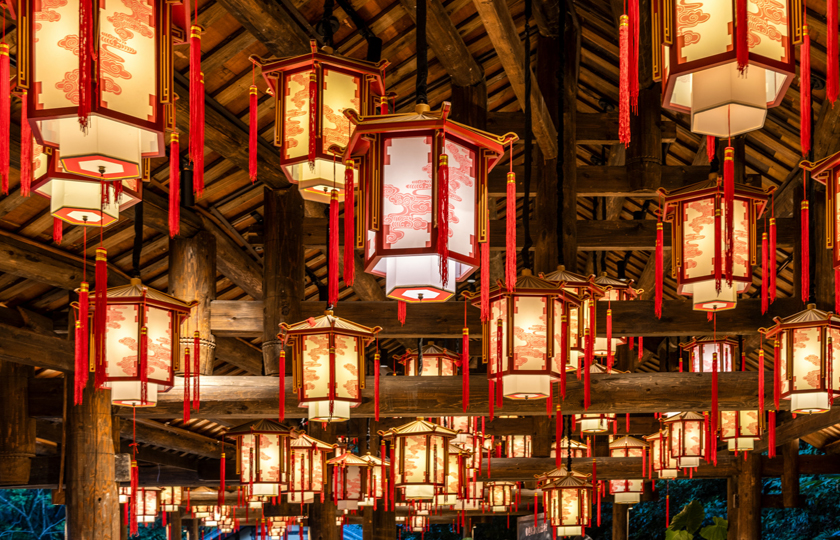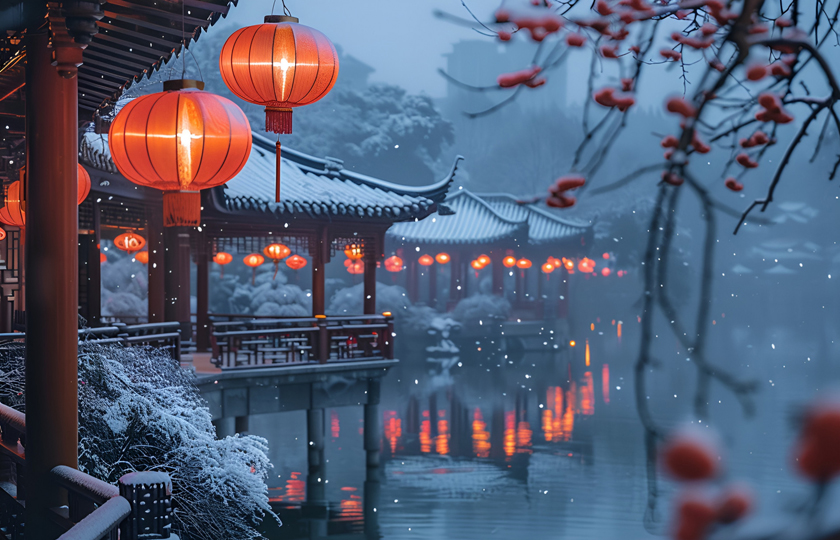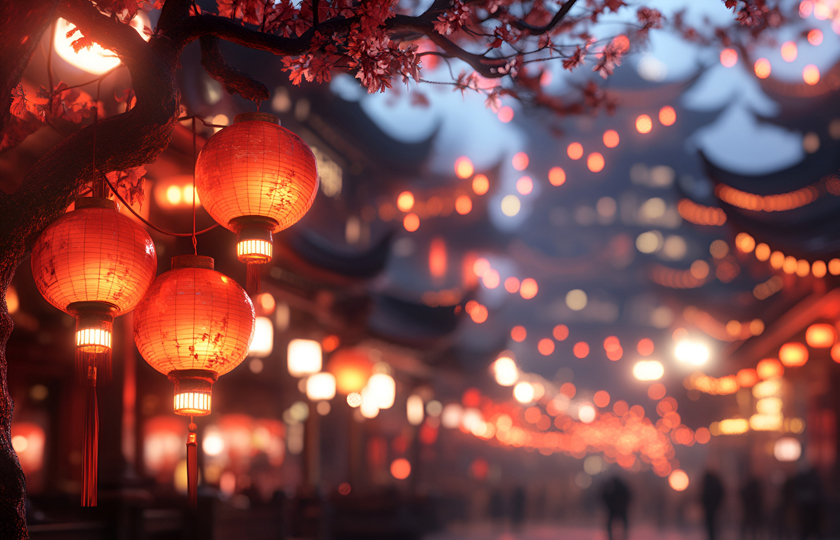Traditional and Vibrant Chinese Lantern Ceremony
Hi, friends! During my travels in China, I discovered a fascinating traditional element—the lantern. It's not just a simple decoration; in China, lanterns are part of unique rituals. These rituals carry rich cultural significance, weaving together folklore and emotions. Today, let’s explore the enchanting world of Chinese lantern ceremonies together!
What are the Chinese lantern ceremony?
In China, lanterns play an important role in various ceremonies.
I. Spring Festival
Hanging lanterns: During the Spring Festival, people will hang red lanterns in front of their doors. Red represents happiness and auspiciousness in Chinese culture. Hanging lanterns implies welcoming the new year, driving away darkness and evil spirits, and bringing light and good luck to families.
Visiting lantern fairs: Some places also hold lantern fairs during the Spring Festival. People walk through holding all kinds of lanterns. It is not only a visual feast but also a blessing ceremony.
II. Lantern Festival
Lantern Festival lantern fair: The Lantern Festival is called the festival of lanterns. This is the grandest time for lantern ceremonies. People will make and buy various lanterns and take to the streets to participate in lantern fairs. Lantern riddles will also be written on lanterns. Guessing lantern riddles is a traditional activity of this festival, which not only adds fun but also passes on culture.
III. Wedding
Wedding procession: In traditional Chinese weddings, there is a lantern ceremony. In front of the wedding procession, someone holds lanterns. One is for lighting, and the other is to symbolize the bright road of life for the newlyweds.
IV. Temple fair
Sacrificial ceremony: Lanterns will appear in temple fairs. Lanterns in sacrificial ceremonies have meanings such as lighting and guiding deities.
What is the origin of the Chinese lantern?
It is said that lanterns originated in the Western Han Dynasty and prevailed in the Tang Dynasty. They have a history of more than 1,800 years.
Initially, lanterns were mainly used for lighting. Later, they gradually developed into a handicraft with decorative and symbolic significance.
In ancient times, the light of lanterns was considered as a power to drive away evil and ensure safety and health. Therefore, people often hung lanterns on festivals or special occasions to pray for peace and happiness.
What is the symbolic meaning and purpose of the lantern?
Symbolic Meanings of Lanterns:
Reunion and Happiness: Lanterns symbolize family reunion and happiness. Especially during the Lantern Festival, families hang red lanterns, signifying togetherness and joy.
Light and Hope: Lanterns represent light and hope, symbolizing the illumination of one's path and providing motivation and direction for moving forward.

Auspiciousness and Protection: In ancient times, people believed that lanterns had the power to ward off evil spirits and bring peace to the household, driving away misfortune and malevolent forces.
Wealth and Prosperity: Lanterns also symbolize wealth and thriving business. Merchants hang lanterns to pray for good fortune and attract customers.
Blessings and Safety: Red lanterns are often seen as symbols of blessings and safety, with people writing auspicious wishes on them, praying for family happiness and well-being.
Uses of Lanterns:
Illumination: The primary function of lanterns was originally to provide light, especially in times when electricity was not widely available, making them essential for nighttime activities.
Decoration: During festivals and celebrations, lanterns serve as decorative items that enhance the festive and joyful atmosphere. For instance, various lanterns are hung to celebrate the Spring Festival and Lantern Festival.
Cultural Heritage: As a part of traditional Chinese culture, lanterns convey and promote Chinese cultural heritage through their creation and display.
Cultural Significance of Lanterns: Lanterns are more than mere lighting tools; they are cultural symbols. They incorporate various crafts, such as painting, paper-cutting, paper-making, and embroidery, and are deeply connected to the lives of Chinese people. Lanterns have become symbols of celebration in China, and through the craftsmanship of artisans over generations, they have developed into a diverse array of forms and techniques.
As an important part of traditional Chinese culture, lanterns embody rich meanings and serve multiple functions, reflecting people’s aspirations for a beautiful life and the profound cultural heritage of the Chinese nation.
Chinese lantern color meanings
Different colored lanterns often carry their own unique meanings and symbolic significance:
Red Lanterns:
Red is the most representative color of Chinese lanterns, symbolizing celebration, good fortune, prosperity, and happiness. During joyful occasions such as the Spring Festival, Lantern Festival, and weddings, red lanterns are everywhere, signifying family reunion, a happy life, and thriving businesses, reflecting people's hopes for a bright future.
Yellow Lanterns:
Yellow lanterns symbolize wealth and prosperity, often used to pray for fortune and good luck. In some regions, yellow lanterns are seen as symbols of wealth, commonly used by merchants to attract customers and signify thriving business.
Other Colored Lanterns:
Beyond red and yellow, lanterns come in blue, white, purple, and other colors, each with its own unique meaning. For example, white lanterns may symbolize purity and innocence, while purple lanterns often signify nobility and mystery.
What are Chinese lanterns used for today?
Modern Chinese lanterns serve a variety of purposes, blending tradition with innovation. Here are some key uses:
Festive Decorations:
Spring Festival and Lantern Festival: Lanterns are essential decorations for these festivals, adorning streets, shops, and homes to create a vibrant festive atmosphere.
Mid-Autumn Festival: Lanterns symbolize the bright moon and family reunion, often used in celebratory activities.

Cultural Activities:
Lantern Fairs: Many cities host lantern fairs showcasing various lanterns, attracting tourists and fostering cultural exchange.
Art Exhibitions: As a form of folk art, lanterns are often displayed in art exhibitions, reflecting local cultural characteristics.
Commercial Promotions:
Opening Celebrations: Businesses use lanterns during openings to attract customers and create a lively ambiance.
Promotional Events: Lanterns are commonly used in promotional activities as decorative elements to draw in customers.
Home Decoration:
Everyday Decor: In modern homes, lanterns can serve as decorative items for indoor or outdoor spaces, adding cultural flair and beauty.
Holiday Decorations: Lanterns enhance the festive atmosphere during various celebrations, particularly weddings and birthdays.
Tourism Attraction:
Scenic Area Decoration: Many tourist spots use lanterns to enhance the environment, encouraging visitors to take photos and explore.
Nighttime Events: Some cities host light shows at night, where lanterns become important visual elements that draw crowds.
Education and Heritage:
Cultural Education: Schools and communities organize lantern-making activities to teach younger generations about traditional culture and craftsmanship.
Festival Activities: Lantern-making and riddle-guessing events promote awareness and transmission of traditional culture.
Artistic Creation:
Design and Innovation: Modern designers blend lanterns with contemporary art, creating new styles that retain traditional elements while integrating modern aesthetics.
























